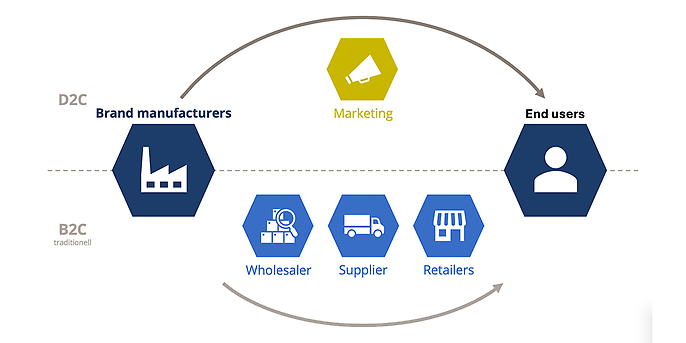24. June 2025 By Miriam Eckardt
Direct-to-consumer (D2C) – distribution and potential
Sales in transition: new opportunities for manufacturers
Technological innovations and digital tools have fundamentally changed sales in recent years. This has opened up previously untapped potential for manufacturers: greater control over their own value chain, direct customer contact and the opportunity to build sustainable customer relationships. The buzzword: direct-to-consumer (D2C).
In this article, you will learn everything you need to know about the D2C sales model – from its definition and advantages to specific challenges.
What does direct-to-consumer (D2C) mean?
In the D2C model, manufacturers sell their products directly to end customers without intermediaries such as wholesalers, distributors or retail partners. This shortens or even completely replaces the traditional distribution channel (manufacturer → wholesaler → retailer → customer).
The aim is to develop a better understanding of your own customers, strengthen brand loyalty, optimise service and ultimately promote sustainable growth.

How does D2C work in practice?
Thanks to modern technologies, it is now possible for almost every manufacturer to operate their own online shop. This direct sales channel can be used to market products, collect data and create a personalised customer journey. The key to success lies in:
- data-driven marketing,
- a clear communication strategy and
- building direct relationships with buyers.
The four core advantages of the D2C approach
1. Price control and independence
Since there are no middlemen, manufacturers can set their own prices – without external mark-ups. For end customers, this often means lower prices, while manufacturers can secure their margins and respond more flexibly.
2. Control over brand presentation
Manufacturers decide for themselves how their products are presented, for example in their own online shop or via social media. Feedback and complaints also go directly to the supplier, which makes it easier to optimise products and services.
3. Valuable customer data – first-party instead of third-party
In the D2C model, companies receive first-party data directly from the customer – without going through retailers.
The most important data sources:
- Online shop analytics
- Newsletter subscriptions
- Customer surveys
- Social listening (e.g. via tools such as Talkwalker)
Please note: The GDPR must be observed at all times; data may only be processed with the appropriate consent.
4. Strengthening customer relationships
Without intermediaries, it is possible to address customers individually, whether through personalised emails, excellent customer service or offers that are tailored precisely to their needs. This increases customer lifetime value and brand trust.
We support you!
Whether you are setting up a high-performance online shop, integrating first-party data or developing a strong D2C strategy, adesso accompanies manufacturers on their journey into the digital sales future.
Our experts combine technology, industry knowledge and implementation expertise to leverage your D2C potential.
Contact us now without obligation and let's realise opportunities together
D2C in action: strategically leveraging customer loyalty
If you know your customers well, you can develop your products and services in a targeted manner. This is not only good for your image, but also for your sales. Because loyal customers:
- buy more often and in larger quantities,
- are more likely to try new products,
- recommend the brand to others,
- provide valuable feedback,
- require less support
- and are more price-sensitive when they trust the brand.
Challenges for established manufacturers in the D2C environment
For many companies, the switch to D2C involves structural, procedural and cultural changes:
- Existing websites must be developed into high-performance online shops.
- Customer data needs a new structure and meaningful analysis.
- Marketing must focus more on social media and CRM.
- Service, logistics and returns processes must be rethought.
This change is not a sure-fire success, especially for traditional manufacturers with established structures, but it is crucial for long-term success.
Conclusion: D2C is more than a trend – it is the future
The direct-to-consumer approach is here to stay. Manufacturers who truly understand their customers and are prepared to take responsibility for sales, communication and service will benefit from a real competitive advantage.
Although technical and organisational adjustments are necessary, the advantages outweigh the disadvantages: more control, direct contact, better data and stronger brand loyalty.
In short, D2C is not a short-term hype, but a sustainable business model for the digital future.
We support you!
Whether you are setting up a high-performance online shop, integrating first-party data or developing a strong D2C strategy, adesso accompanies manufacturers on their journey into the digital sales future.
Our experts combine technology, industry knowledge and implementation expertise to leverage your D2C potential.
Contact us now without obligation and let's realise opportunities together

